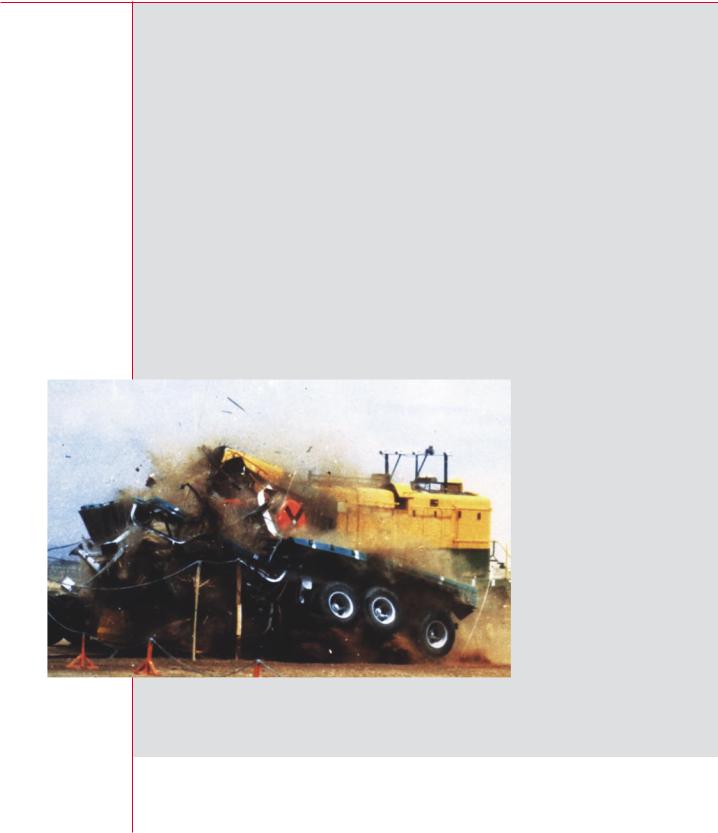
1radiation_people_and_the_environment
.pdf
Chapter 14 / Risks from radiation sources
Lost sources causing contamination incidents
Many sources are sealed devices, with the radioactive material firmly contained or bound within a suitable capsule or housing; others consist of radioactive materials in an unsealed form. Sealed radioactive sources should only present a risk of exposure to external radiation. However, damaged or leaking sealed sources, as well as unsealed radioactive materials, may lead to radioactive contamination of the environment and the intake of radioactive substances into the human body.
Melting of disused radioactive sources accidentally sent with scrap metal for recycling is of particular concern. The table below gives an assessment of the major contamination incidents that have involved sources appearing in the recycled metal industry.
Type of |
Number of reported |
Recycled metal industry |
|
incidents worldwide |
|||
source mislaid |
involved |
||
(1983–1998) |
|||
|
|
||
|
|
|
|
Cobalt-60 |
15 |
Steel (14), Copper |
|
Caesium-137 |
30 |
Steel (27), Aluminium (2), Lead |
|
Iridium-192 |
1 |
Steel |
|
Radium-226 |
3 |
Aluminium (2), Steel |
|
Thorium-232 |
3 |
Aluminium (2), Steel |
|
Americium-241 |
3 |
Aluminium, Copper, Gold |
|
Others |
4 |
Aluminium, Copper, Zinc, Lead |
|
|
|
|
|
Total |
59 |
|
|
|
|
|
Each of these incidents had a significant economic impact on the industry involved, and some also led to environmental and health consequences. In addition to those listed, there are many more cases of lost sources being discovered by radiation monitoring equipment installed by the metal recycling industry. The installation of radiation detectors at recycling facilities is becoming common practice in many countries, and, therefore, the number of serious contamination incidents is expected to decrease.
RADIATION, PEOPLE AND THE ENVIRONMENT
Major contamination incidents involving lost sources
67

Chapter 14 / Risks from radiation sources
Radioactive Dispersal Devices
Although some of the events described above involved the theft of sources by people who didn’t realize the risk, deliberate attempts to use radioactive sources as a terrorist weapon are extremely rare. Since the 11th September, 2001 terrorist attacks in the USA, there has been much speculation about the possibility of terrorists making a radioactive dispersal device or ‘dirty bomb’ using conventional explosives and a stolen radioactive source. Such a bomb could not cause a nuclear explosion, but could disperse radioactive material over an area up to a square kilometre or so. While this might, like the accidents described previously, cause a small number of local casualties, the overall radiation effects would be limited. The wider the material is dispersed, the more diluted it will be and the lower the doses are that people could receive. Nevertheless, severe social disruption could arise. The construction of such a device would be likely to entail dangerously high radiation doses to the terrorists, but would be possible if they were able to obtain a source and were not concerned for their own safety. This possibility reinforces the need for effective measures to ensure that radioactive sources are kept securely under control until they are disposed of permanently.
68 RADIATION, PEOPLE AND THE ENVIRONMENT

Chapter 15 / Transport of radioactive materials
Chapter 15 Transport of radioactive materials |
|
Radioactive materials are routinely transported all around the world by air, sea, |
|
road and rail. These materials include those associated with the nuclear fuel cycle |
|
— from uranium ores to spent fuel and radioactive waste — but also radionuclides for |
|
nuclear medicine and research, and radioactive sources for industry and radiotherapy. |
|
Although the safety record of these transports is excellent, they sometimes cause con- |
|
cern in the areas through which they pass. For example, a number of countries have |
Transport of |
expressed particular concern about ships carrying radioactive waste passing through |
irradiated nuclear |
or close to their territorial waters. |
fuel elements |
Regulations are, therefore, needed not |
|
just to ensure that the chances of an |
|
accident, which could result in radio- |
|
active material being dispersed in the |
|
environment, are kept to a minimum, but |
|
also to ensure that the workers involved |
|
in transport — including those load- |
|
ing and unloading shipments as well as |
|
drivers/pilots — are protected. Because |
|
much of this transport is international, |
|
transport safety was one of the first |
|
areas in which the IAEA developed safety |
|
standards. The IAEA Regulations for the |
|
Safe Transport of Radioactive Material |
|
were first published in 1961 and have |
|
been revised periodically since. |
|
The Regulations govern the necessary packaging, shielding, labelling and other pre- |
|
cautions that must be taken when transporting various types of radioactive material, |
|
including tests that packages must undergo to prove that they can withstand possible |
|
accidents. The requirements are graded according to the level of activity of the mate- |
|
rials to be transported. In general, more hazardous radioactive materials need more |
|
extensive and more robust packaging and stricter quality and administrative controls. |
|
The IAEA’s Transport Regulations are widely accepted as the global standard for |
|
the transport of radioactive materials. In some cases, the Agency’s Regulations are |
|
RADIATION, PEOPLE AND THE ENVIRONMENT |
69 |
|
|

Chapter 15 / Transport of radioactive materials
incorporated into national laws or regulations. Other countries write their own regulations governing transport of radioactive materials, but make them consistent with the IAEA Regulations. Another way in which the Agency’s Regulations are applied is through international regulations on the transport of hazardous goods. The regulations for the different modes of transport are issued by different organizations, particularly the International Civil Aviation Organization (ICAO) for air transport, the International Maritime Organization (IMO) for transport by sea, and regional organizations such as the Inland Transport Committee of the UN Economic Commission for Europe for transport by land and inland waterways. These organizations’ regulations cover all types of hazardous material, and the parts that deal with radioactive materials are based on the IAEA Transport Regulations.
It is generally accepted that compliance with the IAEA Transport Regulations (either directly or via other regulations) assures the safety of workers and the public. However, there are often questions about whether the Regulations are complied with for particular shipments. IAEA surveys have suggested that they are widely implemented.
Testing ability of As a way of demonstrating that they do comply, Member States can ask the IAEA spent fuel to conduct an appraisal of their implementation of the Regulations. An international transport peer review team visits the country, studies their arrangements and then reports their
container to findings and recommendations. withstand impact
of train crash
70 RADIATION, PEOPLE AND THE ENVIRONMENT

Appendix A / Glossary
Appendix A. Glossary
Absorbed dose The energy imparted by ionizing radiation to a suitably small volume of matter divided by the mass of that volume. Unit gray, symbol Gy. 1 Gy = 1 joule per kilogram.
Actinides A group of 15 elements with atomic number from that of actinium (89) to lawrencium (103) inclusive. All are radioactive. Group includes uranium, plutonium, americium, and curium.
Activity The rate at which nuclear transformations occur in a radioactive material. Used as a measure of the amount of a radionuclide present. Unit becquerel, symbol Bq. 1 Bq = 1 transformation per second.
Alpha particle A particle consisting of two protons plus two neutrons (i.e. the nucleus of a helium atom) emitted by a radionuclide.
Atom Unit of matter consisting of a single nucleus surrounded by a number of electrons equal to the number of protons in the nucleus. The smallest portion of an element that can combine chemically with other atoms.
Atomic mass The mass of an isotope of an element expressed in atomic mass units, which are defined as one-twelfth of the mass of an atom of carbon-12. (An atomic mass of 1 is equivalent to about 1.66 × 10-27 kg.)
Atomic number The number of protons in the nucleus of an atom. Symbol Z.
Becquerel See activity.
Beta particle An electron or positron which has been emitted by an atomic nucleus or neutron in a nuclear transformation.
Brachytherapy The use of sealed radioactive sources in or on the body for treating certain types of cancer.
Chromosomes Rod-shaped bodies found in the nuclei of cells in the body. They contain the genes, or hereditary constituents. Human beings possess 23 pairs.
RADIATION, PEOPLE AND THE ENVIRONMENT 71

Appendix A / Glossary
Collective dose The total radiation dose incurred by a population. Frequently used for collective effective dose.
Collective effective dose The quantity obtained by adding the effective doses received by all of the people in a defined population (often all of the people exposed to radiation from a particular source). Unit man sievert, symbol man Sv. Frequently abbreviated to collective dose.
Consumer products Devices such as smoke detectors, luminous dials, or ion generating tubes that contain a small amount of radioactive substances.
Cosmic rays High energy ionizing radiation from outer space. Have a complex composition at the surface of the Earth.
Decay The process of spontaneous transformation of a radionuclide or the decrease in the activity of a radioactive substance as a result of this process.
Decay product A nuclide or radionuclide produced by decay. It may be formed directly from decay of a radionuclide or as a result of a series of decays through several radionuclides. Sometimes referred to as progeny or daughters.
Decommissioning Administrative and technical actions taken to allow the removal of regulatory controls from a facility. Decommissioning typically includes dismantling the facility, but this need not be the case.
Depleted uranium Uranium containing a lesser mass percentage of uranium-235 than the 0.7 per cent found in natural uranium. A by-product from the production of enriched uranium.
Diagnostic radiology The use of radiation (e.g. X rays) or radioactive materials in medicine for identifying disease or injury in patients.
Disposal In relation to radioactive waste, emplacement in an appropriate facility without the intention of retrieval.
DNA Deoxyribonucleic acid. The compound that controls the structure and function of cells and is the material of inheritance.
Dose General term for a measure of the energy deposited by radiation in a target. See the more specific terms absorbed dose, equivalent dose, effective dose and collective effective dose. Frequently used for effective dose.
Effective dose A measure of dose designed to reflect the amount of radiation detriment likely to result from the dose. Obtained by multiplying the equivalent dose to each tissue or organ by an appropriate tissue weighting factor and summing the products. Unit sievert, symbol Sv. Tissue weighting factors are tabulated in Chapter 2.
72 RADIATION, PEOPLE AND THE ENVIRONMENT

Appendix A / Glossary
Electrical interaction A force of repulsion acting between electric charges of like sign or a force of attraction acting between electric charges of unlike sign.
Electromagnetic radiation Radiation consisting of electrical and magnetic fields oscillating at right angles to each other. Ranges from very long wavelengths (low energy) such as radio waves, through intermediate wavelengths such as visible light to very short wavelengths (high energy) such as gamma rays.
Electron A stable elementary particle having a negative electric charge of 1.6 × 10-19 C and a mass of 9.1 × 10-31 kg.
Electron volt Unit of energy employed in radiation physics. Equal to the energy gained by an electron in passing through a potential difference of 1 volt. Symbol eV. 1 eV = 1.6 × 10-19 joule approximately.
Element A substance with atoms all of the same atomic number.
Enriched uranium Uranium containing a greater mass percentage of uranium-235 than the 0.7 per cent found in natural uranium.
Equivalent dose A measure of the dose to a tissue or organ designed to reflect the amount of harm caused to the tissue or organ. Obtained by multiplying the absorbed dose by a radiation weighting factor to allow for the different effectiveness of the various types of radiation in causing harm to tissue. Unit sievert, symbol Sv. Radiation weighting factors are given in Chapter 2.
Erythema Reddening of the skin caused by dilation of blood vessels. Can occur as a result of high radiation doses.
Excitation A process by which radiation imparts energy to an atom or molecule without causing ionization. The energy may be absorbed by the nucleus or the electrons, and may be released in the form of radiation when the atom or molecule ‘relaxes’.
Fallout Airborne radioactive material from the testing of nuclear weapons or nuclear accidents deposited on the Earth’s surface.
Fast neutrons High energy (i.e. fast moving) neutrons, such as those produced by nuclear fission. In reactor physics, conventionally defined as neutrons with kinetic energies greater than 0.1 MeV. Corresponding velocity of about 4 × 106 m/s
Fast reactor A nuclear reactor in which fission is induced predominantly by fast neutrons.
Fission Nuclear fission. The division of a heavy nucleus into two (or, rarely, more) parts with masses of equal order of magnitude, usually accompanied by the emission of neutrons and gamma radiation.
RADIATION, PEOPLE AND THE ENVIRONMENT 73

Appendix A / Glossary
Fission products Nuclides produced by nuclear fission or by the subsequent radioactive decay of the nuclides thus formed.
Free radical An uncharged atom or group of atoms having one or more unpaired electrons which were part of a chemical bond. Generally very reactive in a chemical sense.
Fusion Thermonuclear fusion. The merging of two light nuclei, resulting in the production of at least one nuclear species heavier than either initial nucleus, together with excess energy.
Gamma ray Penetrating electromagnetic radiation emitted by an atomic nucleus during radioactive decay and having wavelengths much shorter than those of visible light.
Geiger–Müller tube A glass or metal envelope containing a gas at low pressure and two electrodes. Ionizing radiation causes discharges, which are registered as electric pulses in a counter. The number of pulses is related to dose.
Genes The biological units of heredity. They are arranged along the length of chromosomes.
Gray See absorbed dose.
Half-life For a radionuclide, the time required for the activity to decrease, by a radioactive decay process, by half. Symbol t1⁄2.
Ion An atom, molecule or fragment of a molecule that has acquired an electric charge through the loss or capture of electrons.
Ionization The process by which an atom or molecule acquires or loses an electric charge. The production of ions.
Ionizing radiation For the purposes of radiation protection, radiation capable of producing ion pairs in biological material(s). Examples are alpha particles, gamma rays, X rays and neutrons.
Irradiation The act of being exposed to radiation. It can be intentional, for example through industrial irradiation to sterilize medical equipment, or accidental, for example through proximity to a source that emits radiation. Irradiation does not usually result in radioactive contamination, but damage can occur depending on the dose received.
Isotopes Nuclides with the same number of protons but different numbers of neutrons. Not a synonym for nuclide.
Man sievert See collective effective dose.
74 RADIATION, PEOPLE AND THE ENVIRONMENT

Appendix A / Glossary
Mass number The number of protons plus neutrons in the nucleus of an atom. Symbol A.
Moderator A material used in thermal reactors to reduce the energy and speed of the fast neutrons produced as a result of fission to become thermal neutrons that can cause further fission.
Molecule A group of atoms bonded to each other chemically. The smallest portion of a substance that can exist by itself and retain the properties of the substance.
Mutation A chemical change in the DNA in the nucleus of a cell. Mutations in sperm or egg cells or their precursors may lead to inherited effects in children. Mutations in body cells may lead to effects in the individual.
Neutron An elementary particle having no electric charge, a mass of about 1.67 × 10-27 kg and a mean lifetime of about 1000 seconds
Non-ionizing radiation Radiation that is not ionizing radiation. Examples are ultraviolet radiation, visible light, infrared radiation and radiofrequency radiation.
Nuclear fuel cycle All operations associated with the production of nuclear energy, including: mining and milling, processing and enrichment of uranium; manufacture of nuclear fuel; operation of nuclear reactors; reprocessing of nuclear fuel; any related research and development; and all related waste management activities (including decommissioning).
Nuclear medicine The use of radionuclides for diagnosing or treating disease in patients.
Nuclear reactor A device in which a self-sustaining nuclear fission chain reaction can be maintained and controlled. (A reactor employing fusion reactions is a thermonuclear reactor.)
Nucleus (of an atom) The positively charged central portion of an atom. Contains the protons and neutrons.
Nucleus (of a cell) The centre of a human cell that controls its functioning. Contains the important genetic material: DNA.
Nuclide A species of atom characterized by the number of protons and neutrons and the energy state of the nucleus.
Order of magnitude A factor of ten or so, or an approximate value of a quantity, given to the nearest power of ten.
Photon A quantum of electromagnetic radiation.
RADIATION, PEOPLE AND THE ENVIRONMENT 75

Appendix A / Glossary
Positron A stable elementary particle having a positive electric charge of 1.6 × 10-19 C and a mass of 9.1 × 10-31 kg (i.e. similar to an electron, but positively charged).
Pressurized water reactor A thermal reactor using water as both moderator and coolant. The water is maintained under pressure to prevent boiling.
Probability The mathematical chance that a given event will occur.
Proton A stable elementary particle having a positive electric charge of 1.6 × 10–19 C and a mass of 1.67 × 10–27 kg.
PWR Pressurized water reactor.
Radiation Energy, in the form of waves or particles, propagating through space. Frequently used for ionizing radiation in the text, except when it is necessary to avoid confusion with non-ionizing radiation.
RadiationdetrimentThetotalharmthatwouldeventuallybeexperiencedbyanexposed person or group and their descendants as a result of their exposure to radiation.
Radioactive Exhibiting radioactivity. For legal and regulatory purposes, the meaning of radioactive is often restricted to those materials designated in national law or by a regulatory body as being subject to regulatory control because of their radioactivity.
Radioactive waste For legal and regulatory purposes, material for which no further use is foreseen that contains or is contaminated with radionuclides at concentrations or activities greater than levels set by the regulatory body.
Radioactivity The phenomenon whereby atoms undergo spontaneous random disintegration, usually accompanied by the emission of radiation.
Radiobiology The study of the effects of ionizing radiation on living things.
Radiation protection (or radiological protection) The protection of people from the effects of exposure to ionizing radiation, and the means for achieving this.
Radionuclide A radioactive nuclide.
Radiotherapy The use of radiation beams for treating disease, usually cancer, in patients.
Regulatory body An organization designated by the government as having legal authority for regulating nuclear, radiation, radioactive waste and transport safety.
Risk The probability of a specified health effect occurring in a person or group as a result of exposure to radiation.
76 RADIATION, PEOPLE AND THE ENVIRONMENT
